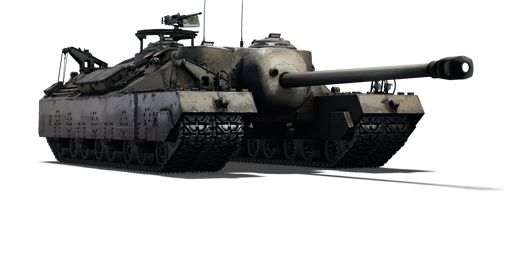



In 1943, the US Army recognised the need for an assault tank capable of defeating enemy fortifications, particularly the German Siegfried line, while having sufficient armour to resist any returning fire. As such, development of the Super Heavy Tank T28 began that same year. The T28 featured extremely thick all-around armour, with frontal armour of 305 mm, and was equipped with a powerful 105 mm T5E1 anti-tank gun. Since speed was not a priority, the T28 had a top speed of just 13 km/h. To cope with its massive weight and ground pressure, the T28 was equipped with a second set of tracks which could be removed for rail transport. By the time two prototypes entered testing in 1945, the Siegfried Line had already been broken. This, along with the realisation that such a heavy vehicle was impractical in combat, led to the cancellation of the project in 1947. The sole remaining prototype is currently preserved at the US Army Armor and Cavalry Collection at Fort Benning, Georgia.
As a side note, the name "Heavy Tank T28" was changed to "105 mm Gun Motor Carriage T95" in March 1945 because its unique turretless design did not fit with the then definition of a "tank". This name is used to refer to the full configuration of the "T95" in War Thunder. However, the tank was again redesignated "Super Heavy Tank T28" in June 1946 as the vehicle was too heavily armoured compared to conventional SPGs, effectively making the T28/T95 a one-of-a-kind vehicle.
Introduced in Update 1.49 "Weapons of Victory", the T95 is a super-heavy tank unlike anything else in the US tree. The T95 is extremely slow but is also exceptionally well-armoured and well-armed. While the top speed of the T95 is the same as its two-tracked premium counterpart, it can traverse its hull towards the enemy at a surprisingly fast speed. Because of this, the T95 can instil fear in its foes, especially in choke points where it is nigh invincible, while also being a top priority target for any CAS, particularly when left alone. The T95 can dispatch almost any tank it can penetrate in one shot, while slowly making its way to victory with proper support from allies.
| Ammunition | Type | Armor penetration (mm) at a distance: | |||||
|---|---|---|---|---|---|---|---|
| 10 m | 100 m | 500 m | 1000 m | 1500 m | 2000 m | ||
| APCBC | 256 | 253 | 238 | 221 | 205 | 190 | |
| HE | 27 | 27 | 25 | 23 | 21 | 20 | |
| APCBC | 253 | 250 | 236 | 219 | 204 | 190 | |
| APCR | 292 | 287 | 266 | 242 | 220 | 200 | |
| Belt | Belt filling | Armor penetration (mm) at a distance: | |||||
|---|---|---|---|---|---|---|---|
| 10 m | 100 m | 500 m | 1000 m | 1500 m | 2000 m | ||
| API-T/I/AP/API-T | 31 | 29 | 21 | 14 | 9 | 6 | |












Mobility | |
|---|---|
Protection |
|---|
Firepower | |
|---|---|